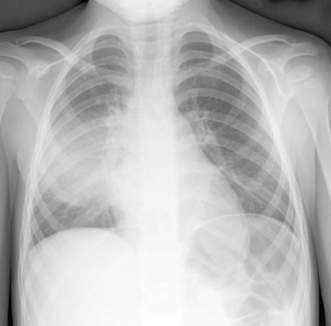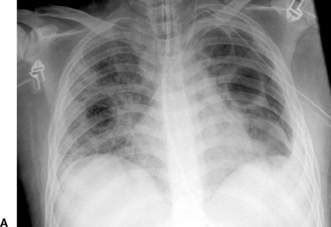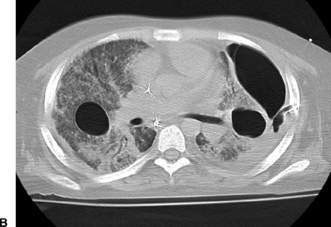14.5 Lower respiratory tract infections and abnormalities
Lower respiratory tract infections
Lower respiratory tract infections (LRTIs) are a major cause of morbidity in developed and developing countries and the greatest cause of mortality in children under 5 years of age in developing countries, with more than 2 million deaths from pneumonia in this age group annually. Respiratory tract infections often involve both the upper and lower respiratory tracts, particularly those due to viruses. For respiratory tract infections that appear to involve mainly the upper airway, involvement of the lower respiratory tract is usually present to some degree. Over the last few years, acute asthma has been shown to be caused mainly by respiratory viral infection of the lower airway, and this is now recognized as the most common form of LRTI. However, this form of LRTI is discussed in the chapter on asthma (see Chapter 14.3).
Pneumonia
• pleural effusion – shifting of mediastinum or trachea, dullness to percussion (stony dullness with large effusions), reduced or absent breath sounds, and bronchial breathing above the effusion
• pneumothorax – uncommon, shifting of mediastinum or trachea, reduced breath sounds.
Pneumococcal pneumonia
Chest X-ray findings vary widely, but the most common and classic finding is lobar involvement (Fig. 14.5.1). A well-defined round opacification is not uncommon and patchy changes can occur. Empyema, abscesses and pneumatoceles are less common than in staphylococcal pneumonia. Increases in white cell count and indices of inflammation are commonly found in peripheral blood, and blood culture may be positive.

Fig. 14.5.1 Pneumococcal pneumonia in a 5-year-old girl, showing opacification in the midzone of the right lung.
Staphylococcal pneumonia
• widespread opacifications, displaced intrathoracic structures and pleural effusions
• more specific to staphylococcal pneumonia:
High-resolution computed tomography (HRCT) of the chest (Fig. 14.5.2B) is often useful in defining the nature and extent of these complications.
Stay updated, free articles. Join our Telegram channel

Full access? Get Clinical Tree




